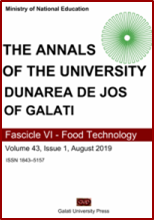Extraction and characterization of bioactive compounds from eggplant peel using ultrasound – assisted extraction
Abstract
This study followed the bioactive compounds extraction and the antioxidant potential of the eggplant peel, using three different solvents (ethanol, methanol and acetone). The successive extraction of total monomeric anthocyanin (TMA), total flavonoids (TFC), and total phenolic compounds (TPC) from eggplant peel was done by using an ultrasound – assisted extraction. The results showed that the highest bioactive compounds content was achieved for the methanol extract, which was characterized by 0.74 g D-3G/g d.w. of TMA, 5.48 g CE /g d.w. of TFC, 14.72 g GAE/g d.w. of TPC, compared to the ethanol and acetone extracts. Moreover, for the methanol extract, six anthocyanins were identified (delphinidin- 3-rutinoside, delphinidin-3-glucoside, cyanidin-3-rutinoside, delphinidin-3- rutinoside-5-glucoside, malvidin-3-rutinoside-5-glucoside and petunidin-3- rutinoside), while for the ethanol extract, five anthocyanins were identified (all without malvidin-3-rutinoside-5-glucoside) and for the acetone extract only two anthocyanins were detected (delphinidin-3-rutinoside, delphinidin-3-glucoside). The antioxidant potential of the eggplant extracts was investigated by DPPH method. Results showed that the methanol extract had the highest antioxidant activity (51% inhibition of DPPH radical at a concentration 27.2 mM TE/g d.w.), followed by the ethanol and acetone extracts (39 % and 33% DPPH radical inhibition rate at a concentration 22.4 and 17.04 mM TE/g d.w., respectively). Ultrasound-assisted extraction is promising because the extracts rich in bioactive compounds can be obtained at low cost.


